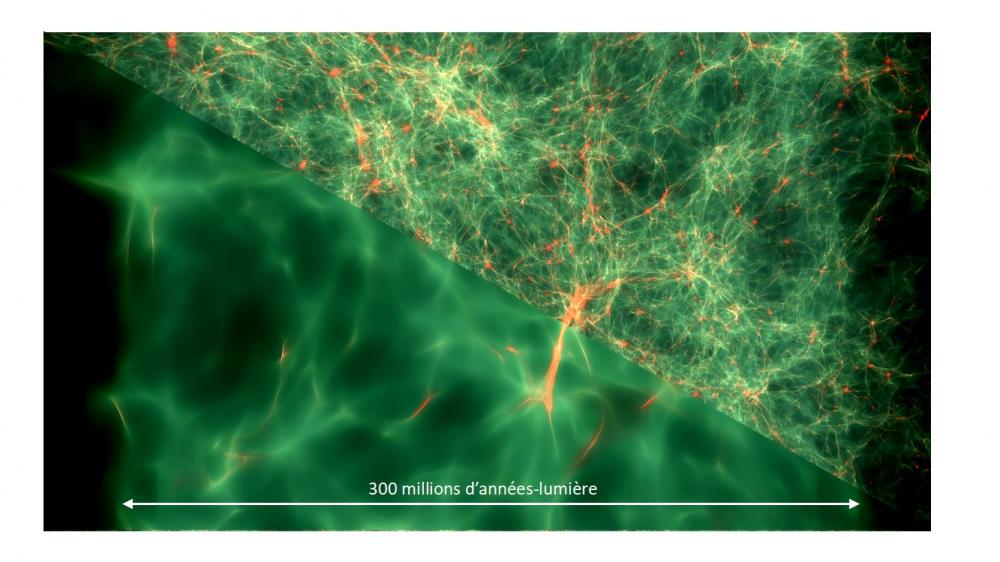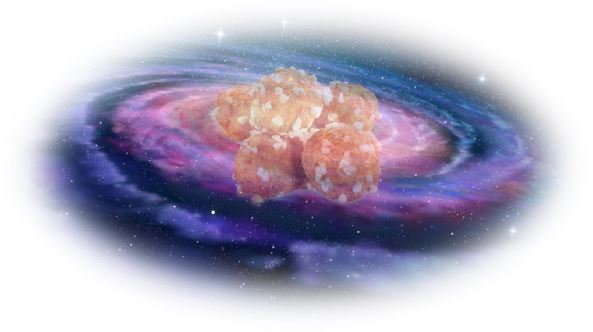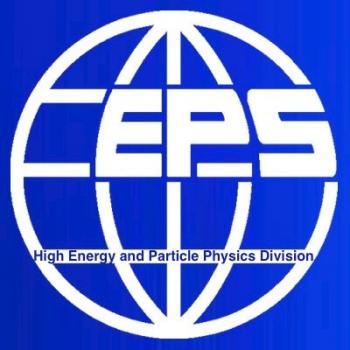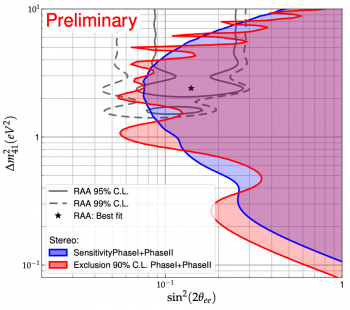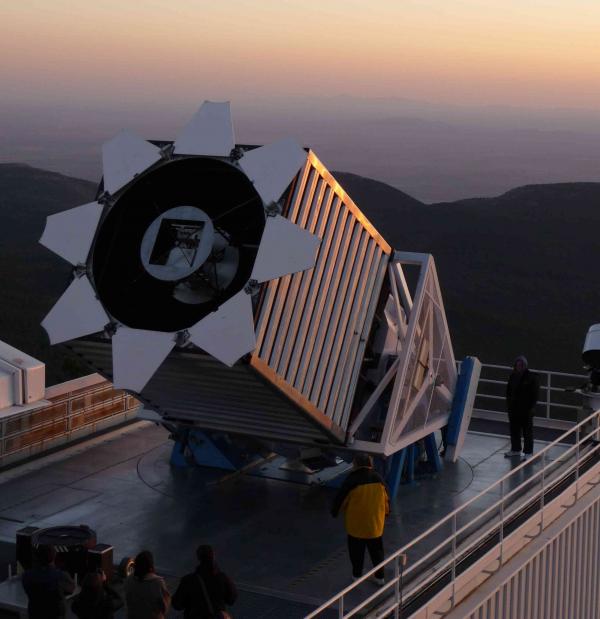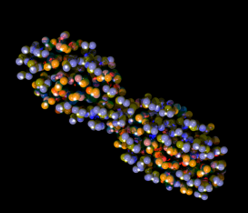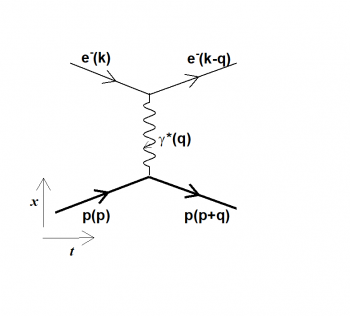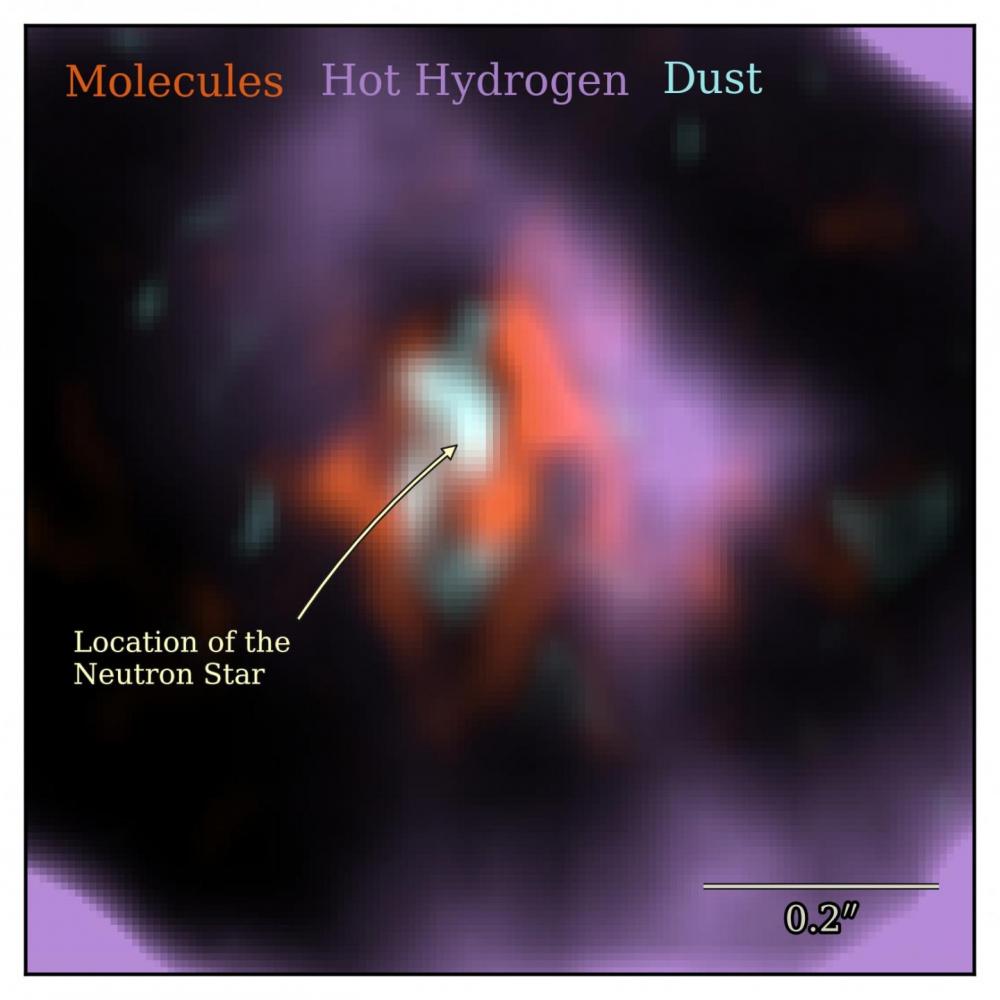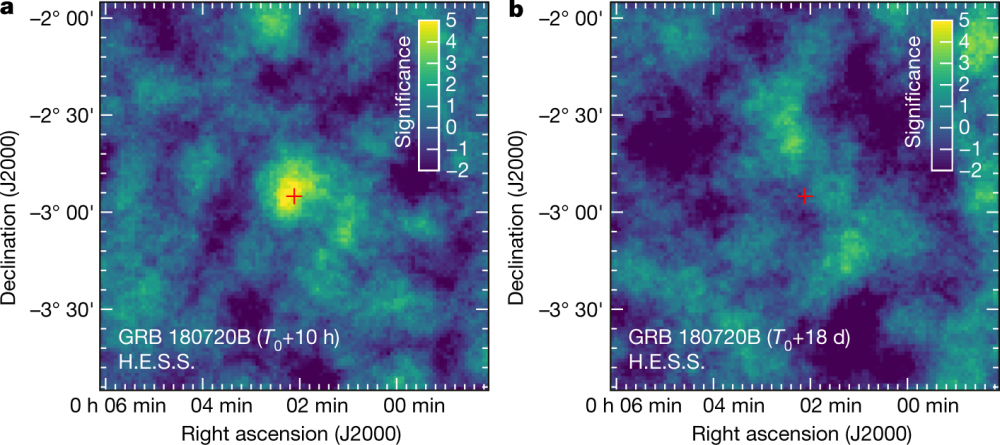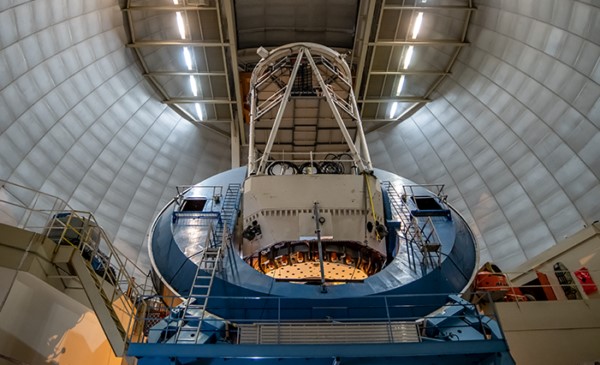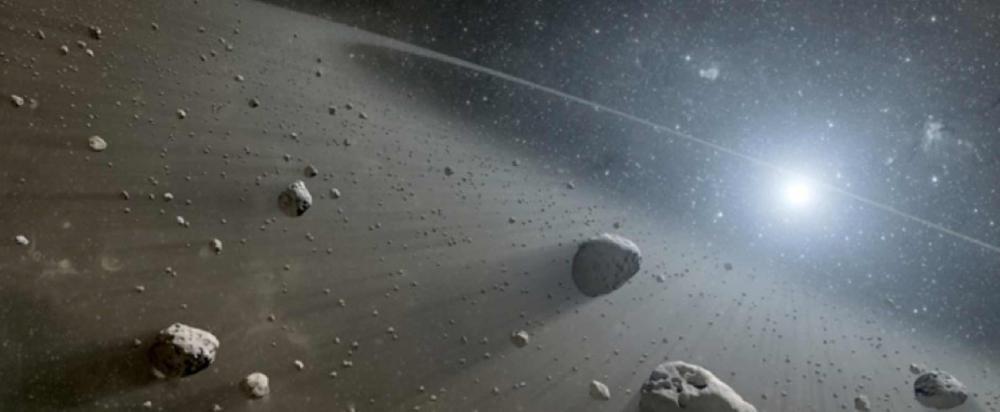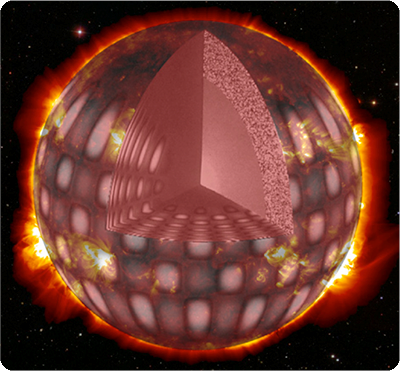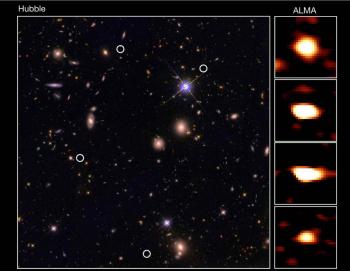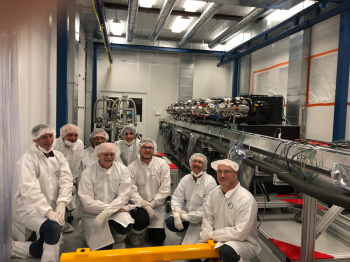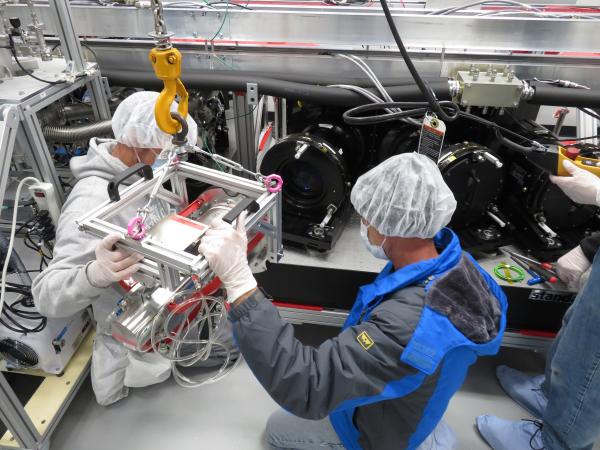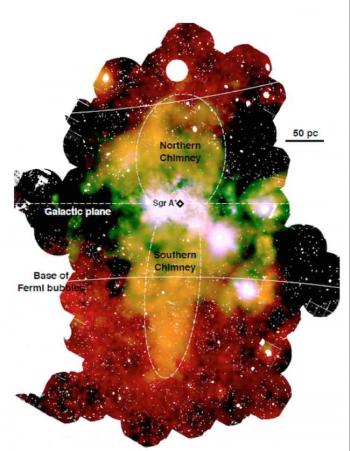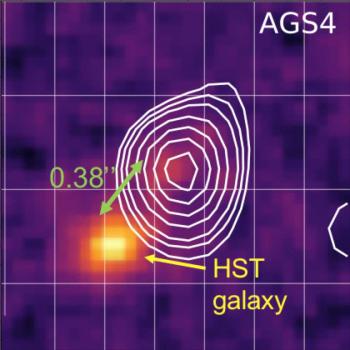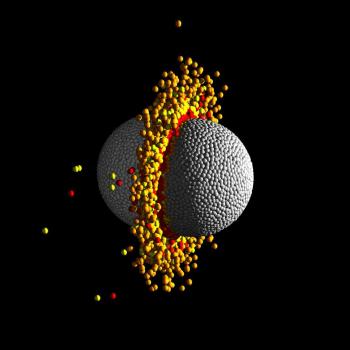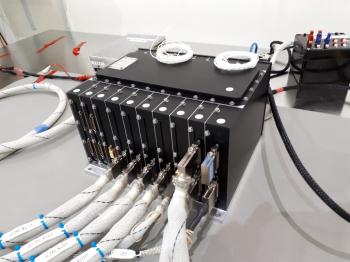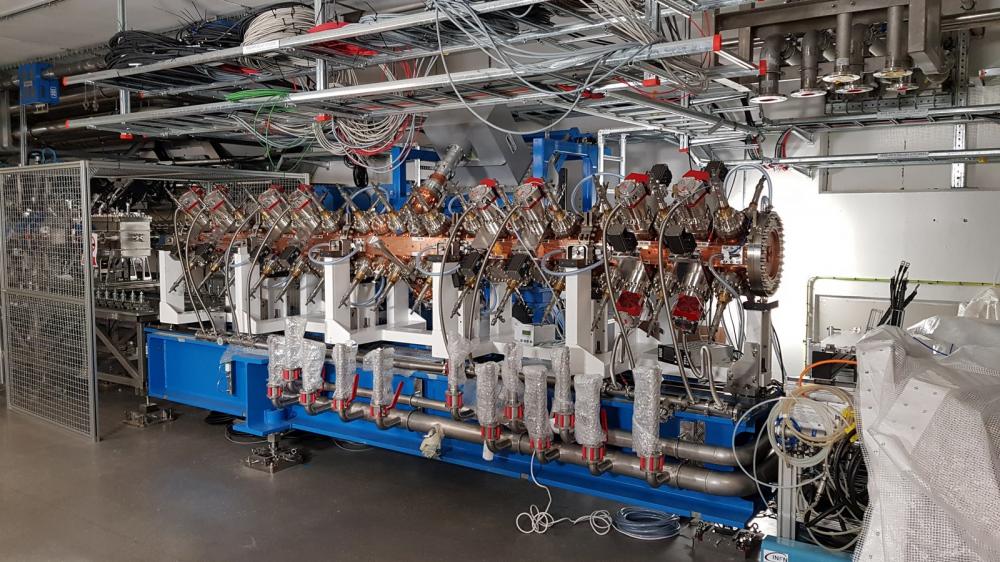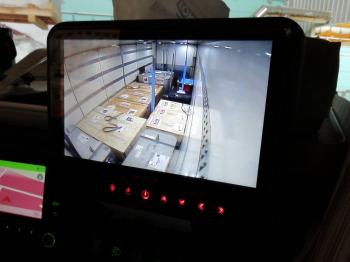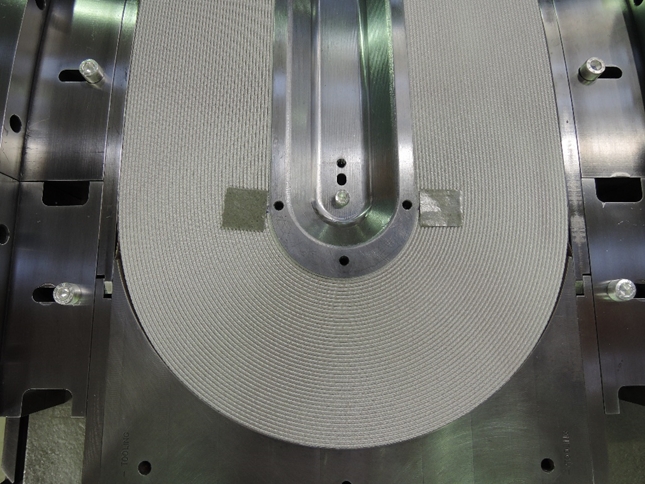A team from IRFU's Department of Particle Physics (DPhP) has just conducted the most accurate study to date of the mass of cosmic neutrinos, including both standard model neutrinos and sterile neutrinos contributing to dark matter.
The researchers used the spectra of nearly 200,000 distant quasars measured by the Sloan Digital Sky Survey (SDSS) eBOSS project to map the distribution of hydrogen at very remote times in the history of our universe, ten to twelve billion years ago.
Neutrinos, propagating at relativistic speeds for billions of years, prevent gravity from acting on small scales and smooth the structures (clusters of galaxies, filaments, ...) revealed by the spectra of quasars. Thanks to the accuracy of the measurements, researchers have been able to narrow the possible range for the mass of cosmic neutrinos, to the point of being able to have their word on how the different masses of the three neutrinos of the Standard Model are ordered.
The missing mass of the universe or non-baryonic dark matter is probably made up of particles that remain to be discovered. Massive and neutral, with very weak interactions, they still escape a detection that would identify them. While conventional photons are massless, dark matter could be made up of particles of a new type, similar to massive photons. New experimental results on the search for non-baryonic matter in this form, obtained by a team of three Irfu members, have just been published in Physical Review Letters[1].
The FIFRELIN code simulates nuclear fission and de-excitation of the nuclei produced therein. STEREO is a compact neutrino detector that looks for a hypothetical sterile neutrino. Two a priori separate topics developed at CEA, the first at DEN, the second at DRF/Irfu, which have however recently met to achieve unprecedented precision on a crucial ingredient in the detection of neutrinos: the de-excitation of a gadolinium nucleus after the capture of a neutron. The results of this meeting have just been published in the journal The European Physical Journal A [1].
The Tevatron CDF and D0 collaborations have just received the 2019 Prize for Particle and High Energy Physics awarded by the European Physical Society for the discovery of the top quark in 1995 and the detailed measurements of its properties from 1995 to the present. This prize thus rewards the physicists and engineers of the Irfu who contributed to the construction of the D0 detector, the discovery of the quark top, and conducted numerous studies on top quark physics.
The STEREO experiment releases new results based on the detection of about 65000 neutrinos at short distance from the research reactor of the ILL-Grenoble. The improved accuracy is rejecting the hypothesis of a 4th neutrino in a large fraction of the domain predicted from the reactor neutrino anomaly. Profiting from a good control of the detector response, STEREO now also releases its first absolute measurements of the neutrino rate and the spectrum shape.
Neutrinos from the Big Bang have been traveling the Universe for more than 13 billion years. They are almost undetectable but their footprint on the formation of large structures in the Universe, such as galaxies, can be detected. For the first time, this trace of the "diffuse neutrino background" from the Big Bang on the "baryonic acoustic oscillations" (BAO) has been deduced from the survey of 1.2 million galaxies of the "Sloan Digital Sky Survey" (SDSS). These data correspond to 5 years of observations from the Baryon Oscillation Spectroscopic Survey (BOSS) experiment, a ground-based telescope installed in New Mexico. The result, published in the journal Nature Physics, shows how the BAO phase can constrain the number of neutrino species in the Standard Model of Particle Physics.
The DPhP group has been involved in this project for more than 10 years and is currently working on its extension, the eBOSS project. In the very near future, the DESI project will be able to study even more precisely this cosmic neutrino background produced by the Big Bang.
For the first time, a team of researchers was able to measure and accurately identify daughter nuclei produced by the fission of uranium-239 fission. This was made possible by the unique combination of GANIL equipment and beams. It is published in the Physical Review Letter*.
It is possible to trace the shape of a drum from its vibration modes. Similarly, it is possible to measure the 3D structure of the proton and access its elementary components, quarks and gluons, from observables obtained using deeply virtual Compton scattering experiments off the proton. By studying this scattering process, we can access this geometric information. This research topic is very active and mobilizes a large international theoretical and experimental community. As part of the PARTONS (PARtonic Tomography Of Nucleon Software) project, physicists from Irfu and NCBJ in Warsaw successively performed two detailed analyses using all the measurements associated with this process published since the early 2000s. This represents nearly 2600 measurement points and 30 observables from 6 different experiments. This work, published in the European Physical Journal C [1, 2], is now the most advanced analysis of these experimental data. New data, combined with new analysis methods, will enrich the PARTONS library in the future; these observables (Compton form factors) will make it possible to go one step further in the reconstruction of the proton structure in 3D.
The series of Jefferson Laboratory (USA) experiments dedicated to the measurement of electron-proton elastic scattering showed that the extracted information on the proton structure did not agree when extracted from two kinds of experiments. To reconcile these results, it was suggested that, beyond the exchange of one photon, that is the dominant mechanism, the exchange of a second photon could become important. The presence of a second photon would bring serious consequences, casting doubts on the results of number of experiences. That’s why the search of such mechanism motivated three independent experiments, recently realized. We have analyzed all the obtained results and shown that two photon exchange is not enhanced. Other explanations are favored, as a precise calculation of radiative corrections. This study, performed by two researchers of IRFU and JINR-BLTP, Dubna (Russia) has been published in the Physical Review C[1].
Predicting properties of, e.g., molecules or atomic nuclei from first principles requires to solve the Schrödinger equation with high accuracy. The computing cost to find exact solutions of the Schrödinger equation scales exponentially with the number of particles constituting the system. Thus, with nuclei composed of tens or hundreds of nucleons, it necessitates accurate approximate methods of lower computing cost. However, such methods can be applied to a limited number of systems: the weakly correlated ones. Consequently, a universally applicable method is still missing. Employing a novel formalism recently developed at Irfu/DPhN [1], highly accurate solutions of the Schrödinger equation – in the context of the exactly solvable Richardson model - have been obtained, independently of the weakly- to strongly-correlated character of the system. This work has been performed in collaboration with ab initio quantum chemists from Rice University. This exciting new achievement, paving the way for precise ab initio computations of molecular or nuclear properties of a large number of systems, was recently published in Physical Review C [2] and highlighted as the Editor’s suggestion.
Pairing is ubiquitous in physics. From superconductivity to quantum shell structure, coupling particles into pairs is one of nature's preferred ways to lower the energy of a system. New results obtained at the Radioactive Isotope Beam Factory (RIBF, Japan) with the MINOS device, which was conceived and constructed at Irfu, show for the first time that pairing also plays an important role in single-proton removal reactions from neutron-rich nuclei. These results show that proton-removal cross sections can be used as a tool to investigate pairing correlations for very neutron rich nuclei not accessible via spectroscopy. Indeed, the latter are produced in too small quantities to consider spectroscopy, studying the gammas emitted during de-excitation for example. This study was recently published in Physical Review Letters [1].
An international collaboration led by the institutes of CEA-IRFU and of RIKEN (Japan) demonstrates, for the first time, the exceptional stability of the very-neutron rich nickel-78 nucleus and its doubly-magic character. The experiment at RIKEN was made possible by the unique combination of the MINOS device developed at CEA-Irfu and the very exotic beams produced by the RIBF facility of the Japanese accelerator.These results are published in Nature [Nat19].
A team from IRFU's Department of Particle Physics (DPhP) has just conducted the most accurate study to date of the mass of cosmic neutrinos, including both standard model neutrinos and sterile neutrinos contributing to dark matter.
The researchers used the spectra of nearly 200,000 distant quasars measured by the Sloan Digital Sky Survey (SDSS) eBOSS project to map the distribution of hydrogen at very remote times in the history of our universe, ten to twelve billion years ago.
Neutrinos, propagating at relativistic speeds for billions of years, prevent gravity from acting on small scales and smooth the structures (clusters of galaxies, filaments, ...) revealed by the spectra of quasars. Thanks to the accuracy of the measurements, researchers have been able to narrow the possible range for the mass of cosmic neutrinos, to the point of being able to have their word on how the different masses of the three neutrinos of the Standard Model are ordered.
An international team, led by astronomers from Cardiff University, with the contribution of the Astrophysics Department of CEA-Irfu, may have spotted for the first time the compact remains of the last star explosion visible by eye that occurred on February 23, 1987 in a nearby galaxy, the Large Magellanic Cloud, only 160 000 light-years away.
Using the high-resolution images of the ALMA radio telescope in the Atacama Desert in northern Chile, the team discovered a small area of dust, warmer than its environment, which may correspond to the supposed location of the compact neutron star that should have formed during the explosion according to theoretical models. This compact object had been searched without success for more than 30 years. This indirect discovery nevertheless requires to be confirmed by additional data. These results are published in The Astrophysical Journal.
The missing mass of the universe or non-baryonic dark matter is probably made up of particles that remain to be discovered. Massive and neutral, with very weak interactions, they still escape a detection that would identify them. While conventional photons are massless, dark matter could be made up of particles of a new type, similar to massive photons. New experimental results on the search for non-baryonic matter in this form, obtained by a team of three Irfu members, have just been published in Physical Review Letters[1].
After a decade-long search, scientists have for the first time detected a gamma-ray burst in very-high-energy gamma light. This discovery was made in July 2018 by the H.E.S.S. collaboration using the huge 28-m telescope of the H.E.S.S. array in Namibia. Surprisingly, this Gamma-ray burst, an extremely energetic flash following a cosmological cataclysm, was found to emit very-high-energy gamma-rays long after the initial explosion. This discovery was published in Nature.
‘First light’ for the Dark Energy Spectroscopic Instrument (DESI): as the installation phase nears completion, this new instrument is due to undergo final tests before starting to create a giant map of the sky in early 2020, a mission that is scheduled to run for five years. CEA, the French National Centre for Scientific Research (CNRS), Aix-Marseille University and French company Winlight System have played a significant role in the project to develop this international instrument which aims to scan the sky in an attempt to understand the effects of dark energy.
An international team led by researchers from the CEA Paris-Saclay Astrophysics Department (DAp) have probed for the first time the dust envelopes surrounding stars in formation (so-called Class 0 protostars) thanks to the large interferometer NOEMA (former Plateau de Bure, France). Surpisingly, the researchers discovered the presence of large grains whose size grows as one gets closer to the central star. The presence of such large grains, already forms a few 10000 years after the beginning of the initial gas collapse is extremely unexpected. These grains are the building blocks from which planets will be formed. These results could thus call for a major revision of the timeline and timescales to form planets. These conclusions are published in Astronomy & Astrophysics.
Lisa Bugnet is one of 35 young women researchers who won the L'Oréal-Unesco Fellowships for Women in Science in 2019. As an asteroseismologist at the Dynamic Laboratory of Stars, (Exo)planets and their Environment of the DAP/Irfu, she uses seismic waves emitted by stars to probe their heart and understand their evolution from birth to the end of their life.
The first results of the space mission SVOM (for Space-based multi-band astronomical Variable Objects Monitor) have just fallen before the launch scheduled for the end of 2021. How is this possible? Quite simply because this ambitious Franco-Chinese mission, which aims at studying gamma-ray bursts of the Universe, is also developing a network of ground-based cameras able to detect the emission of visible light that follows the outbreak of these bursts, the most violent known explosions. This network, dubbed Ground-based Wide Angle Camera (GWAC), is already in operation at the Xinglong Observatory in Northeast Beijing (China). Its test version, dubbed Mini-GWAC, successfully concluded a first campaign of monitoring and real-time follow-up of gravitational wave sources discovered by the LIGO (USA) and Virgo (Italy) facilities. These results are being published in the journal Research in Astronomy and Astrophysics.
A study conducted by astrophysicists of the Department of Astrophysics-AIM Laboratory of CEA-Irfu has revealed a large number of galaxies as massive as the Milky Way in the distant universe, thanks to the large interferometer ALMA (Atacama Large Millimeter/submillimeter Array) in Chile. These galaxies have hitherto remained invisible due to the attenuation of their brightness by interstellar dust. They are 10 to 100 times more numerous than all those detected so far, at distances where the universe was only two billion years old. This great abundance of massive galaxies in the young universe is in contradiction with current theoretical models of galaxy formation and represents a new challenge for our understanding of the early ages of the universe. These results are published in the journal Nature on August 7, 2019.
The installation of DESI, the Dark Energy Spectroscopic Instrument at the Kitt Peak Observatory in Arizona, has just passed an important milestone: with 6 operational spectrographs on site, the minimum configuration required to meet the scientific objectives of the project has been reached. At the end, DESI will have 10 spectrographs and will commit itself from 2020 to the spectroscopic survey of 35 million galaxies and quasars, to study the dark component of the Universe. Irfu, responsible for the cryogenic part of the spectrographs, has made a major contribution to the success of this installation and is currently finalizing the qualification of the cameras of the last spectrograph in Saclay. In parallel, other essential milestones for the construction of the instrument are achieved.
The Dark Energy Spectroscopic Instrument (DESI) is intended to make the spectroscopic survey of 35 million galaxies and quasars from 2020 onwards, to study precisely the properties of dark energy. Its installation, started in 2018, has recently entered a new phase with the reception and assembly of the first two spectrographs out of the 10 that the instrument will include. Irfu, partner of the project since the beginning and responsible for the cryogenic part of the spectrographs, has successfully completed this installation. The next 8 spectrographs will be installed next May and September under the coordination of the Irfu team, in partnership with the local teams.
vidéo réalisée par Victor Silva (Irfu/DIS)
Thanks to the X-ray satellites Chandra and XMM-Newton, an international team including the Department of Astrophysics of CEA-Irfu has just discovered the existence of two bubbles of hot gas escaping to distances of about 500 light-years, on both sides of the massive black hole environment, in the center of our galaxy. Like the messages of Native Americans transmitted by smoke bubbles visible from afar, these "hot gas chimneys" tell us today about the intense past activity of the black hole and the central regions of our Galaxy. These results are published in the journal Nature of March 21, 2019.
An international team, led by researchers from the Department of Astrophysics/AIM Laboratory of CEA-Irfu has just highlighted a new population of very remote galaxies, which had so far escaped the deepest observations of the Universe. During the summer of 2016, at more than 5000 meters of altitude on the Chilean highlands, the antennas of the large interferometer ALMA (Atacama Large Millimeter/submillimeter Array) scrutinized for more than 20 hours one of the best studied regions of the sky. These observations revealed galaxies still unknown, very massive but opaque, emitting only a very small amont of visible light due to a large quantity of dust. These "dark" galaxies, very far away, which could be the progenitors of the most massive galaxies in the universe, reveal that the importance of star formation, during the first billion years of cosmic history, could have been largely underestimated so far. These results have just been published in the journal Astronomy & Astrophysics.
Neutrinos from the Big Bang have been traveling the Universe for more than 13 billion years. They are almost undetectable but their footprint on the formation of large structures in the Universe, such as galaxies, can be detected. For the first time, this trace of the "diffuse neutrino background" from the Big Bang on the "baryonic acoustic oscillations" (BAO) has been deduced from the survey of 1.2 million galaxies of the "Sloan Digital Sky Survey" (SDSS). These data correspond to 5 years of observations from the Baryon Oscillation Spectroscopic Survey (BOSS) experiment, a ground-based telescope installed in New Mexico. The result, published in the journal Nature Physics, shows how the BAO phase can constrain the number of neutrino species in the Standard Model of Particle Physics.
The DPhP group has been involved in this project for more than 10 years and is currently working on its extension, the eBOSS project. In the very near future, the DESI project will be able to study even more precisely this cosmic neutrino background produced by the Big Bang.
An international collaboration, involving the Astrophysics Department-Laboratory AIM of CEA irfu, participated in the study of an exoplanetary system, Kepler-107 and revealed an amazing distribution of its 4 planets of which two seem potentially resulting from a giant impact. Thanks to asteroseismology (the study of star vibrations) and the modeling of planetary transits, researchers have been able to determine the mass and radius of the central star and its planets with great precision. and highlighted the unusual density of one of the planets. This anomaly can be explained by a giant collision between planets, probably similar to the one that affected the Earth in the past to form the Moon. These results are published in the journal Nature Astronomy of Februrary 4th, 2019.
On November 29, 2018, the first version of the ECU software for the ECLAIRs instrument was delivered.
This computer, called Gamma Camera Management and Scientific Processing Unit, will be set on the Franco-Chinese SVOM satellite, designed to study gamma-ray bursts. It will allow the management of the ECLAIRs instrument and the detection of gamma-ray bursts by the SVOM mission in real time on board. This software, under the scientific responsibility of the DAp, is produced in strong collaboration between the DAp and the DEDIP within the IRFU.
On December 4, 2019, mechanical reception of the RFQ provided by Irfu took place in the tunnel of the European Spallation Source (ESS) project in Lund, Sweden. Following the delivery of the RFQ on August 27, 2019, the installation immediately followed with the Irfu team present and guaranteeing its success over the following months.
August 27, 2019, a key accelerator component from France was delivered to the European Spallation Source (ESS) in Lund, Sweden, as part of the French in-kind contributions to the next-generation research infrastructure. The Radio Frequency Quadrupole (RFQ) is the first accelerating structure in ESS’ linear accelerator and has been designed, developed and manufactured by the ESS French stakeholder CEA in its institute Irfu (Institute of Research into the Fundamental Laws of the Universe).
After winding, the seventh and last coil of FRESCA2 left Saclay in June 2019 in its reaction mould, putting an end to Irfu's activity on this project, which began in 2009 in collaboration with CERN. This type 3-4 coil is a spare coil, which, after reaction, instrumentation and impregnation at CERN, will join its type 1-2 sister on CERN shelves.
In a first step, the FRESCA2 dipole, a 100 mm Nb3Sn dipole magnet tested at CERN, had reached a field of 13.3 T (see highlight of 20/09/2017). A new series of tests in April 2018, after modifying the mechanical preloading of the magnet, allowed the FRESCA2 dipole to reach 14.6 T at a temperature of 1.9 K, representing a new field record for a dipole of this aperture. During these tests, the stability of its operation was validated at 14.4 T at 1.9 K, and at 13.6 T at 4.5 K respectively. The dipole has been qualified: it will now be able to be used as a test station to accommodate, in particular, tests of small magnets made from high temperature superconductors.

